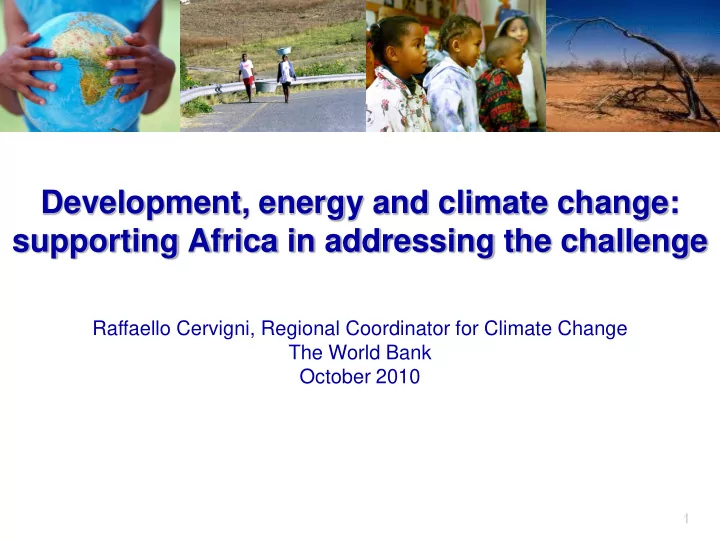

Development, energy and climate change: supporting Africa in addressing the challenge Raffaello Cervigni, Regional Coordinator for Climate Change The World Bank October 2010 1
Outline 1. Context 2. The role of development cooperation: the case of the World Bank 3. Strategic issues for discussion 2
Context 3
Africa hosts several new poles of growth… 4
..but it badly needs energy to keep growing.. 560 million sub-Saharan Africans lack access to electricity
..and is severely threatened by the climate of the future Projected Percentage Change in Agricultural output in 2080 6
Africa relies heavily on biomass as source of energy… 7
..but Africa’s forests holds a large mitigation potential Annual economic mitigation potential in the forestry sector by world region and cost class in 2030 Source: IPCC, 2007 8
Africa is has a huge hydro-power potential..
..but it confronts large uncertainty on the climate of the future Nile Basin: Scenarios of rainfall changes in 2050 from different climate change models
The role of development assistance: the case of the World Bank 11
Strategy: results of extensive consultation process 1: Integrate adaptation and climate risk into development Countries represented at CC strategy consultation meetings 25 2. Take advantage of 20 4. Scale up financing development 15 opportunities opportunities with 10 5 mitigation co-benefits 0 Tunis Addis Ababa Pretoria Dakar 3. Focus on knowledge and Four consultations meeting capacity (May-June 2008) Over 50 countries represented development Over 300 people attending
The Strategy: four Pillars 1. Integrate adaptation and climate risk management into development 2. Seize mitigation opportunities Synergies adaptation – mitigation Land management, energy and transport 3. Knowledge and capacity development Data, knowledge and capacity for better climate risk management 4. Scale up financing IDA main platform, but also Adaptation Fund, Climate Investment Funds (CIFs), and other instruments 13
Strategy progress: at a glance Strategic policy dialogue : integration of CC in CASs, CPSs, e.g. Nigeria, Ethiopia, Burkina Faso and Cameroon Analytical work : over 40 tasks planned or under way in FY09-FY12 to address critical knowledge gaps Investment operations: 60% of FY10 projects support activities that contribute – directly or indirectly- to the implementation of the regional climate change strategy (preliminary estimates)
Energy and climate work: a synopsis Area Realized in FY09-10 Planned for FY11-12 1 million efficient cooking stoves and i. Further expansion of stoves and Energy Efficiency 5 million CFLs displacing diesel fuel CFL distribution in Ethiopia i. Bumbuna HPP in Sierra Leone (50 MW) i. Rusumo Falls HPP (regional) ii. Bujagali HPP in Uganda (250 MW) ii. Geothermal in Ethiopia and Renewable energy iii. Felou HPP in Mali, Senegal and Kenya Mauritania (59 MW) iii. Hydropower in Mali iv. Geothermal in Kenya (280 MW) v. RE credit line in Tanzania Lighting Africa i. Expand to Ethiopia, Mali, Senegal, i. Several pilots in Kenya, Ghana Program Tanzania, etc. Climate risk i. South Africa through CTF i. Botswana low carbon growth management in ii. Botswana CPS strategy policy dialogue Carbon finance i. 7 projects in 5 countries (Uganda, i. 5 projects targeted in 3-4 deals Rwanda, Mali, Kenya, Senegal) countries
Niger Basin: integrating climate into energy/ water investment plans $8.3b 20 year Sustainable Development Action Plan (SDAP) - investments in storage, irrigation, hydropower, transport, water supply, fisheries, environment, capacity-building Request from Heads of State - Bank supporting Niger Basin Authority on a climate risk assessment of the SDAP Innovative methodology - establish system performance indicators and examining their vulnerability to climate risks (both from the historical variability record and climate change scenarios)
Nigeria Climate Change Assessment (WB/ UNDP) 1. Develop a solid knowledge platform on Low carbon growth options → NAMA (?) Risks to growth from climate variability and change (Agriculture, Water, Hydro; Lagos) 2. Provide underpinning for follow-up financial assistance by the donor community Climate-risk lending operation (World Bank) Support from the Global Environment Facility, under GEF-5 Climate-finance instruments (e.g. Copenhagen Green Fund)
Making climate data accessible for internal and external use 18
Addressing the CC/ Infrastructure nexus Africa Infrastructure Country Diagnostic (AICD ): data platform on power, water, transport and ICT infrastructure in SSA Adding a climate overlay to evaluate cc implications for: Water storage needs Cost of expanding/ maintaining road networks Power generation and regional trade 19
For further information http://beta.worldbank.org/content/africa http://www.infrastructureafrica.org/ http://sdvmd1.worldbank.org/climateportal/ (under development) 20
A few strategic issues for today’s discussion 21
Savings from power import (US cents per kWh) at low cost… Regional power trade can deliver energy 0 1 2 3 4 5 6 7 8 Guinea-Bissau Liberia Niger Angola Chad Burundi Senegal Mali Congo Equatorial Guinea Mozambique Sierra Leone Lesotho Namibia South Africa Gabon Kenya
…and to manage climate risks.. Potential benefits of the Ethiopia and Kenya interconnection Through hydrologic complementarity, could contribute to hedge hydrologic risks and contribute to increase total “firm energy” of the join system Red to blue = higher to lower hydrologic risk Shows potential for lowering risk through interconnecting systems in Ethiopia and Kenya 23
Growing low carbon: need for planning tools.. Mexico – marginal abatement cost curve
..but also for sector reform and governance average cost of system losses and collection losses as % of billings 400 350 300 250 200 150 100 50 - Performance Management High High regulation High reform contracts with contract or governance incentives concession present yes no
..and finally, the financing challenge To address the access gap, Africa needs to build 7,000 MW of generation capacity per year More than five million new power connections per year An extensive transmission network The annual financing requirements are staggering Spending needs: US$40.6 bn/yr Existing spending: US$11.6 bn/yr Efficiency gap: US$5.9 bn/yr Financing gap: US$23.6 bn/yr And doing this in a low carbon, climate resilient way is likely to require more resources
Recommend
More recommend